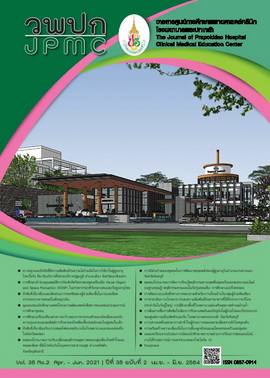The Development of Home Visit Nursing Record Forms for Bedridden Participants
Main Article Content
Abstract
BACKGROUND: The current home visit nursing record forms in bedridden patients quite diverge. Some part of the forms lack of caregiver’s competency and social welfare that needs to be addressed to assist planning. Therefore, the development of a home visit nursing records in the bedridden patient needs to be revised to suit the patient’s need and be specific as well as easy for the nurses running a home visit.
OBJECTIVES: To study, develop, and assess the relevance and satisfaction of using the revised home visit nursing record form among the nurses, the bedridden patient and their caregivers.
METHODS: A sample of this Research and development study consisted of 5 home visit nurses, recruited purposively and 29 bedridden patients’ with their caregivers. This study was conducted during July-December, 2020 and divided into two phases: 1) the home visit nursing record form development and 2) the assessment of relevance and satisfaction of using the revised home visit nursing record form. The research tools consisted of: 1) the revised home visit nursing record form, yielding OIC of 0.90 and its manual, 2) the relevance appraisal form, and 3) the satisfaction appraisal form. Data were analyzed using percentages, mean, and standard deviation.
RESULTS: The findings revealed the revised home visit nursing record form consisted of 3 sections: 1) information of the patient and caregiver, 2) assessment of home visit and 3) identification of the patient and family problems. In addition, the revised form contained both opened and closed-ended questions, emphasis on the actual problems assessment of the patient and caregiver, social welfare assistance needs and problem prioritization. The 5 nurses were female, had the average age and working experiences of 48.4 years and 25.6 years, respectively. The relevance assessment of the nurses was at a high level and demonstrated a high degree of practical possibilities. The patients and caregivers also satisfied with the revised form at a high level particular the process and procedure of a home visit ( = 3.5, SD = 0.4), staff and personnel service delivery (= 3.7, SD = 0.4), and the quality of service delivery (= 3.6, SD = 0.5).
CONCLUSIONS: The revised home visit nursing record form has been developed and is quite suitable for running home visits of the bedridden patient. The professional nurses are satisfied and are able to create comprehensive nursing care plans; thereby the patient and caregiver are pleased with the service delivery.
Article Details
References
Nakkul N. The development of a care model for home-bound and bed-bound chronically ill patients in Suratthani Municipality. Nursing Journal of The Ministry of Public Health 2018; 28(3): 36-50.
Prasartkul P. Situation of the Thai elderly 2017. Bangkok: Octoberprint; 2018.
Miinistry of Public Health. Quality criteria for home visitation. Nonthaburi : Nursing Division; 2013.
Wongcharoen N, Ratchatathanarat T, Somngam P. Development of continuity of care model for stroke patients. Academic Journal of Community Public Health 2563; 6(4): 61-71.
Atthawong P, Anusornprasert N, Sardlee H. Home nursing care (HNC) for bed-ridden patients from primary care unit (PCU). The Southern College Network Journal of Nursing and Public Health 2017; 4(1):73-85.
Chobsook C, Arayathanitkul B, Lamtrakul S, Tonseni W, Pumsrinil P, Yingprasert P. Development of a nursing documentation form of pediatric intensive care unit, Phramongkutklao Hospital. Journal of The Royal Thai Army Nurses 2018; 19(2): 231-40.
Punpraw D, Meethien N. Development of nursing documentation for patients care in post-anesthesia care unit: Mahasarakham Hospital. Mahasarakham Hospital Journal 2020;17(2):85-93.
Miinistry of Public Health. Home ward. Bangkok : Nursing Division; 2013.
Thana K, Klunklin A. Nursing documentation: the nurses’ most important evidence. Nursing Journal 2015;42(1): 164-70.
The Joanna Briggs Institute. Joanna Brigss Institute reviewer’s manual 2014 : the systematic review of economic evaluation evidence. South Australia: The Joanna Briggs Institute; 2014.
Mykkänen M, Miettinen M, Saranto K. Standardized nursing documentation supports evidence-based nursing management. Stud Health Technol Inform 2016;225:466-70.
Thurapang P, Mahasena P, Panuwet R, Intharakasem S. The development of the homebound patient and bedbound patient care system in Tambon Nong Bou Amphoe Moung Nong Bua Lamphu Province. Journal of Health Science and Community Public Health 2018;1(2): 15-29.
van Hoof J, Wetzels MH, Dooremalen AM, Overdiep RA, Nieboer ME, Eyck AM, etal. Exploring innovative solutions for quality of life and care of bed-ridden nursing home residents through codesign sessions. J Aging Res [Internet]. 2015 [cited 2020 Mar 12]; 2015:185054. Available form: https://www.hindawi.com/journals/jar/2015/185054/
Boonmagul G. The effects of home visit program for nursing therapeutics at the end of life stage of cancer patients at a tertiary level hospital in the Department of Medical Services under the Ministry of Public Health [PhD thesis]. Bangkok: Christian University of Thailand; 2015.

